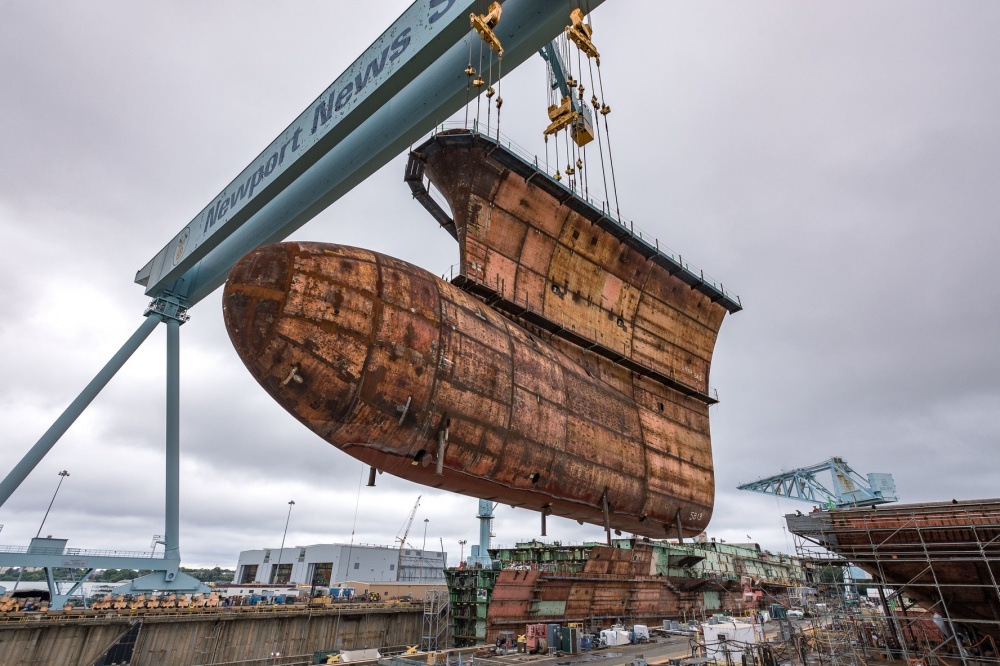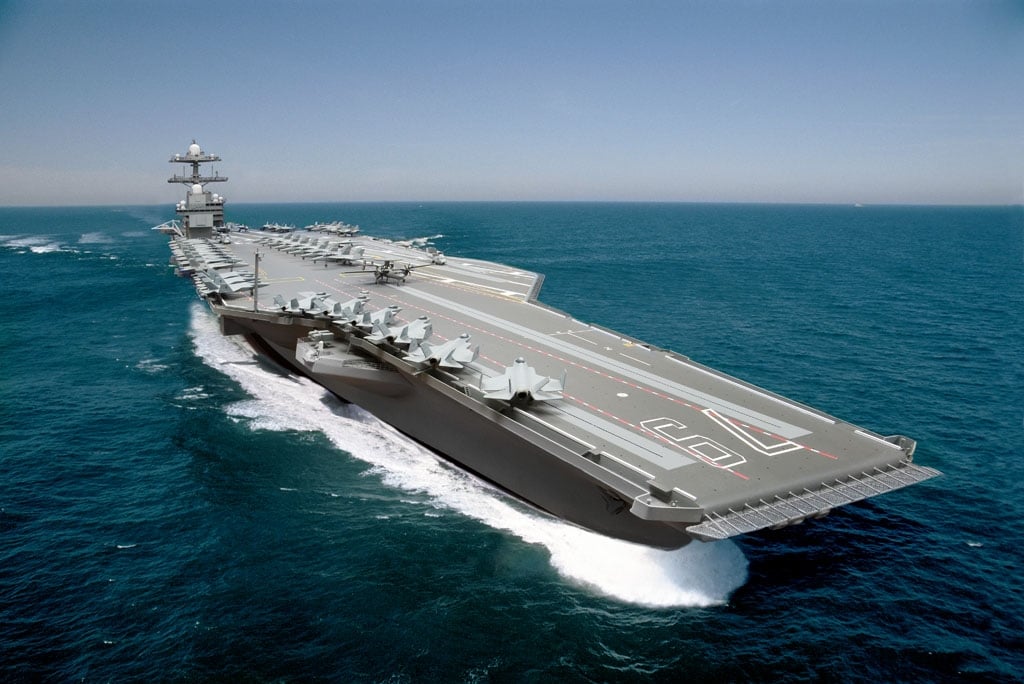
The final piece of the underwater hull of the future aircraft carrier USS John F. Kennedy (CVN 79) is lowered into place at Huntington Ingalls Industries Newport News Shipbuilding in September. Photo courtesy of Huntington Ingalls Industries.
Huntington Ingalls Industries executives expect the future aircraft carrier John F. Kennedy (CVN-79) to launch by the end of 2019, which is ahead of schedule and will occur roughly six years since the christening of first-in-class USS Gerald R. Ford (CVN-78).
Kennedy – about 84 percent structurally complete and 53 percent complete overall – is ahead of schedule and fewer manhours are being used to build the ship, Mike Petters, chief executive of Huntington Ingalls Industries (HII), said Thursday during a conference call discussing the company’s third quarter financial results with Wall Street analysts.
“I think [Government Accountability Office] did a report and pointed out that the best manhour reduction from one ship to the next in the carrier program was like 9 percent,” Petters said. “Our performance today is 15 percent.”
For the quarter, HII reported revenues of $2.1 billion, compared to revenues of $1.9 billion a year ago. Earnings for the quarter were $229 million, compared with earnings of $149 million a year ago, according to the company’s Securities and Exchange Commission filings.
The use of digital shipbuilding imagery is a major reason for the reduction in manhours, Petters said. The images are more accurate and provide workers a more precise guide of what jobs need to be accomplished, reducing the time to perform tasks and cutting the number of jobs requiring rework. Long-term, HII’s goal is for all ship designs to be 3-D and digital, Petters previously told USNI News.
For HII, securing a long-sought-after two-carrier contract for CVN-80 and CVN-81 relies heavily on proving the follow-on Ford-class carriers can be built on time and within budget, Petters said. The Fiscal Year 2019 National Defense Authorization Act authorizes a “two-carrier buy if anticipated savings can be confirmed,” Petters said.
Currently, Congress has set a cap for Kennedy at $11.4 billion, which if maintained, would represent nearly 15 percent drop in price from Ford’s $13 billion price tag. Interestingly, a 15 percent price drop is what HII officials have previously stated was the goal for the third Ford-class ship.

A composite photo illustration representing the Ford-class aircraft carrier John F. Kennedy (CVN-79). US Navy Image
Whether the Navy and HII can achieve such savings has been a near constant source of debate on Capitol Hill. Critics of Ford’s construction, which ran billions of dollars over budget and two years behind schedule, often cite this history when voicing skepticism of Kennedy’s schedule.
“CVN-78 costs over $2 billion more than estimated and the Navy accepted delivery of the carrier over two years late, yet still before it was complete,” the GAO said in a June 2017 shipbuilding report.
Production manhours are the top reason costs can balloon, according to the report. However, the Navy’s plan for building CVN-79 was considered by GAO analysts as overly optimistic regarding scheduling and accounting for various risk factors that could delay construction and drive up costs.
“For example, the Navy is unlikely to achieve planned construction efficiencies and is still developing technology necessary to meet requirements. Therefore, costs for CVN-79 are likely to exceed the $11.4 billion estimate,” the GAO report states.
When discussing Kennedy’s progress on Thursday, Petters said by beating past expectations for reducing manhours and staying within budget, HII will be in a strong position at a time defense spending is expected to get tougher.
“I’m pretty happy with where we are because I think we are in a much more competitive position and I think our products are going to be more affordable,” Petters said. “In an environment where every dollar in the budget is a knife fight, that’s not a bad place for us to be.”
